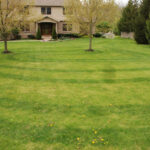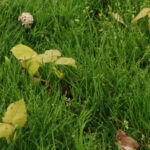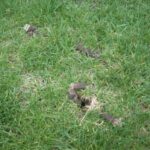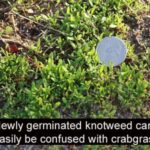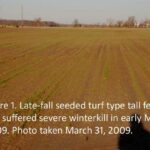Turf Tips Archives
Changing soil pH under turf
Soil testing is important in turf to help determine the soil pH and fertilization needs, especially for potassium and phosphorus. Acceptable soil pH for turf is between 6.0 and 7.5, but often soil tests show pH levels higher or lower than this. pH higher than 7.5: Some firms will recommend applying sulfur to reduce the […]
Responsible fertilization of home lawns
A properly fertilized turf has fewer weeds, is more resistant to insects and disease, and decreases water runoff compared to malnourished turf. Concern over the negative effects of nutrient enrichment on water quality is a growing public concern and has led many to start to question turfgrass fertilization practices. Although both nitrogen and phosphorus may […]
Volunteer tree seedlings in lawns?
I’ve gotten a number of calls asking about volunteer maple and other tree seedlings growing in lawns. These are direct descendents of a neighborhood tree whose seed pods released last spring/summer. You can either stake a couple of these small trees and nurture them over time to become a formidable maples, or you can control […]
Yellow Patch Is Active!
Yellow patch, also referred to as cool season brown patch, is caused by Rhizoctonia cerealis, a fungus closely related to the pathogens that cause brown patch and the Rhizoctonia large patch of zoysia grass. Although symptoms can be striking, yellow patch causes only cosmetic damage and does not affect playability. It occurs most often on creeping […]
Spring Lawn Aerification
Aerification, sometimes called core cultivation is a supplementary lawn cultural practice primarily used to relieve soil compaction and remove thatch (the spongy layer of undecomposed stems at the soil surface). This practices is not necessarily essential to maintaining a lawn, however, it can be very beneficial to most turf areas. In addition, to the aforementioned […]
Gypsum as a soil amendment? Probably not
Garden centers often advertise applying gypsum to your lawn to “decompact” the soil by improving the structure of clay soil. This only works in soils common in the arid western US where there is much more sodium than calcium in the soil. This does not work in Indiana because the parent material for most of […]
Seeding into areas where preemergence herbicide was applied this spring
A fairly typical question now is, ”Can I seed into an area where preemergence herbicide was applied earlier this spring”. The answer is a very simple “No”. These herbicides are active in the soil for up to 120 days and their nature is to be absorbed into the root of a germinating weed (or turfgrass […]
Season-long Grub Control Advertisements
Grub control products are currently being displayed in the center aisles of retail department and discount stores and are advertised on the radio as providing season-long grub control when applied in early May. What are the facts behind this recommendation? While certain grub control products do have a very long residual in the soil, they […]
Professionals Only: Spring Dandelion Control
Though fall applications are most effective for controlling broadleaf weeds, spring applications are warranted for new customers or areas that did not get treated last fall. Spring applications will be most effective if you wait until dandelions are at or near flowering, but still not as effective as fall applications. Applications before mid-April will only […]
Dandelions: Friend or Foe?
The annual bloom of dandelions is already here in southern Indiana and just around the corner in the rest of the state. Though some find dandelions attractive and some may actually eat them in salads or wine, others consider dandelions as weeds and try to control them in a lawn. The optimum time to control […]
Spacing between passes with a rotary spreader
Rotary spreaders are widely used by homeowners and professionals for most applying fertilizers and pesticides. So to test your knowledge, here’s a question that I constantly ask of professionals and do-it-yourselfers when spreading fertilizer back and forth on a turf area: A. Your current pass should spread product so it just touches the edge of the […]
Knotweed germinating next to sidewalks and other hotspots
Prostrate knotweed is currently germinating in thin areas next to sidewalks, cart paths, driveways and other hotspots. Knotweed is often confused with crabgrass at this early stage. Knotweed leaves have rounded leaf tips whereas crabgrass has leaf tips that come to a dull point (See photos). Crabgrass also has veins running lengthwise (parallel veination) whereas […]
Purdue Turfgrass Research Report Available On-Line
The summary of our turfgrass research in the year 2008 is now available at www.agry.purdue.edu/turf/report/2008/index.html. The overall goal of our research program is to minimize inputs while maintaining turf quality, minimizing costs, and further protecting our environment. Our research summary contains over 20 reports of on-going research at Purdue University . The report is a cooperative […]
For professionals only: Poa annua seedheads
Poa annua seedheads are just around the corner in most of Indiana and it’s high time to apply Embark or Proxy/Primo for seedhead reduction on golf courses. The seedhead models on our GDD Tracker at http://www.gddtracker.net indicate most of Indiana should be applying now. Embark and Proxy/Primo can effectively reduce seedheads of Poa annua, which tends to allow the Poa to […]
Billbugs on the move in Southern Indiana
Superintendants and lawn care professionals in the southernmost counties of Indiana should be advised that adult billbug activity has already been documented at one of the monitoring sites in the Evansville area. Mr. Jeff Sexton, Assistant Superintendant at Rolling Hills Country Club in Newburgh, Indiana captured his first billbugs adults of the year last week. […]
Lots of Colors in Spring Lawns
During spring green-up, lawns may reveal many variations in color, growth rate, and leaf width. This variation can be due to some of the following reasons: Species and cultivars: Perennial ryegrass is always the first of the desired cool-season grasses to green-up, followed by tall fescue and eventually Kentucky bluegrass (Fig. 1). Even within a species, […]
Winter damage in cool-season turf
I’ve gotten a number of calls on winter damage on lawns and other high mowed turf areas. Thankfully this is fairly rare in most winters throughout Indiana. Winterkill can be fairly complex resulting from desiccation with drying winds, freezing of the plant crown with quickly dropping temperatures after spring green up, and/or from direct cell […]
Turf 101: Spring Mowing
Though lawns in southern Indiana may have already been mowed a couple of times, mowing is just starting from Indianapolis north. Mowing is the most expensive and laborious maintenance practice on turf, but it also has the largest effect on long-term performance: It is better to mow too early rather than too late in the […]
Turf 101: Limit Spring Fertilization
Many different strategies exist on spring fertilization, but the one fact agreed upon by all turf specialists is to avoid applying heavy nitrogen (N) rates in March or April. Heavy rates would be anything greater than 0.75 lbs of quickly available N/1000 ft2, which causes excessive shoot growth and results in frequent mowing. Furthermore, excess […]
MSMA is a “stop sale” agreement, not a “stop use”
As a follow up to the Feb. 13 Turf Tip on the new restrictions on MSMA, the Indiana Office of the State Chemist indicates this is “stop sale agreement” and not a “stop use”. Therefore, you are free to use according to the label on the actual container, any MSMA that you have in storage […]
